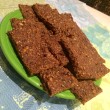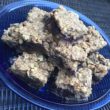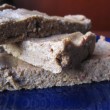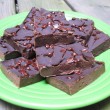Yoga For Anxiety with Dr. Rachel

I originally came up with these “Chill Yoga” poses for Shape Magazine back in 2012, but, we all need tools to combat anxiety more than ever now, in the midst of the CoronaVirus pandemic and social isolation, so, while the poses are all still relevant, I wanted to give this post an update and refresh. In order to learn more about WHY yoga is such a useful tool for reducing anxiety, I reached out to my dear friend, Dr. Rachel Goldman, PhD, FTOS, licensed Psychologist.
According to Dr. Rachel (as she prefers to be called), “when we feel threatened or in a challenging situation, it sets off a chain of physical changes that prepares our body to either fight or flight. The body shifts its energy resources towards fighting off a threat, or fleeing an enemy. This anxiety is not always a bad thing as it can help motivate us and helps us stay alert and focused, but when anxiety is constant and overwhelming, or our body remains in this fight-or-flight response, it results in chronic stress which can lead to many health conditions.
When people experience anxiety, it comes from a place of feeling like the stress is out of their coping abilities, and out of their control. Yoga can be something that you have complete control over. Further, when people are anxious they typically describe their body as being tense and their mind racing as they quickly jump to irrational conclusions regarding what might happen. Yoga (and breathwork) can do the complete opposite and help us relax, both physically and mentally, by stretching and lengthening our muscles, and by being in the present moment. Both yoga and breathing exercises can help calm the mind and the body, which will in turn bring one’s body back to a state of homeostasis, and out of that “fight-or-flight” response.”
Whatever the reason for YOUR stress fest (COVID or otherwise), as this happens, sleep and breathing become more difficult, which in turn creates more anxiety—it’s a vicious cycle that needs to be broken!
Naturally, I prescribe yoga as the fix, but I always prefer science and medicine to back up anything I recommend, so very grateful for Dr. Rachel’s expertise and input here. She agrees that Yoga helps us be more aware of our body, emotions, and the mind-body connection, and when we are more aware of what is happening on the inside, we have a shot at taking more control.
In addition to the following moves, which teach us to be present in the moment (when we are focus on the present, we can’t be thinking or worrying about the future or past), try alternate nostril breathing to ease anxiety and calm a busy brain that doesn’t want to stop bouncing around. There are a plethora of poses geared toward grounding and stilling the mind, these are a few of my favorites. I recommend doing them all if you have time, or picking a few of your favorites whenever your thoughts won’t stop running around or your anxiety starts to climb.
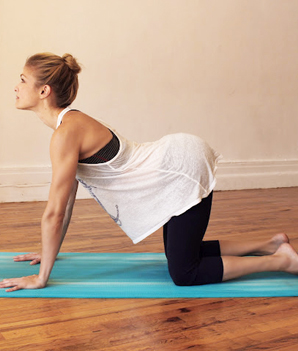
Cow/Cat
While these are technically two poses, one is not often done without the other to counter. Alternating between these several times in a row solidly links your breath to your movement and calms the mind. Cat/cow repetitions also relieve any abdominal cramping caused by anxiety.
Come to all fours with hands under shoulders and knees under hips. On an inhale, look up and arch spine, rolling shoulders away from ears for cow. As you exhale, press the floor away with hands and knees, and round your spine (like an angry Halloween cat). Do at least five complete breath cycles (five inhales/cats and five exhales/cows).
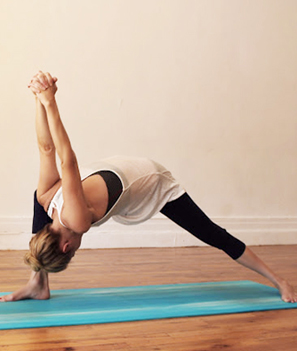
Devotional Warrior
Open both the hips and shoulders—two places that tighten when we’re anxious—and improve focus with this pose.
From down dog, step right foot forward, spin back heel down, and inhale arms up to frame head in warrior one. Then allow hands to fall behind you, clasp them behind sacrum, take a big inhale to open chest, and use your exhale to fold yourself inside of your right knee. Stay here for at least five deep breaths, then repeat on the other side.
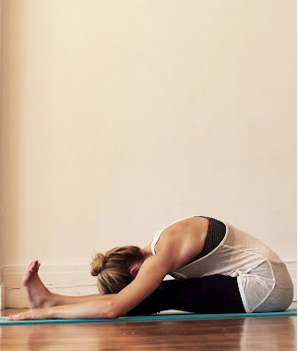
Seated Forward Fold
Do this introspective pose when you want to generate self-reflection /when you need to just take a pause or moment. Ie. when you feel anxiety creeping in as prevention.
From a seated position, extend legs long in front of you and together. Keeping knees soft, take a deep breath to fill yourself with space, and use your exhale to lean forward into the space you just created. If you have a tight lower back, sit on a block or blanket. Take at least five deep breaths here.

Supported Backbend
Backbends across the board open the chest and increase the size of your breath. However, active backbends can be very exhilarating, and that can increase anxiety. In this supported variation, the chest area is able to expand without any of the effort needed for an active backbend, leading to relaxation.
While sitting, place a medium-height block behind you vertically beneath where your shoulder blades will lay and place another block behind that one vertically to use as a pillow for your head. (Use lower blocks if this height doesn’t feel great on your back.) Allow your body to gently rest on the blocks, adjusting their placement until you are comfortable, with arms resting on either side. If you would like to lower the head block down a level (as shown), that will open your chest and back even more. Stay here for at least five deep breaths.
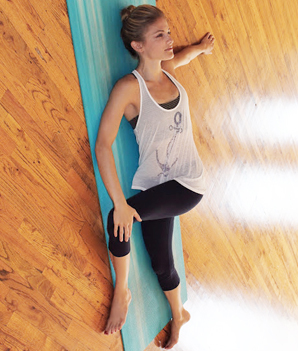
Twist
Erase any negative energy or unwanted thoughts with twists. With each exhale, picture yourself wringing out like a sponge, getting rid of what you don’t want or need in your body or mind.
Lying on the ground, hug right knee into chest, “T” arms out to either side, and allow right knee to fall to the left. You can stay with a neutral neck or, if it feels good, look to the right. You can also take left hand to right thigh to allow the weight of your hand to ground your twisted leg. Stay here for at least five deep breaths, and then repeat on the other side.
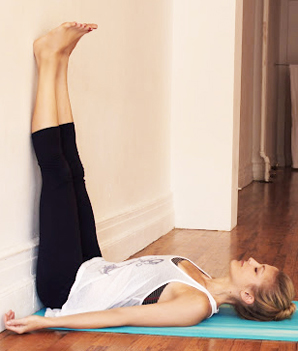
Legs up the Wall
This pose allows your nervous system to chill, reroutes circulation, grounds you, and brings you back to the present. By doing this, you will allow your body to return to homeostasis, aka a non “fight or flight” state.
Sit sideways next to a wall and then lie down on side, facing away from the wall with butt touching it. Using arms, lift legs up the wall as you roll over onto back. Allow arms to fall on either side of you. Palms can face up for openness or face down for an extra level of grounding. Stay here for at least five breaths or, if you feel good, as long as you like.
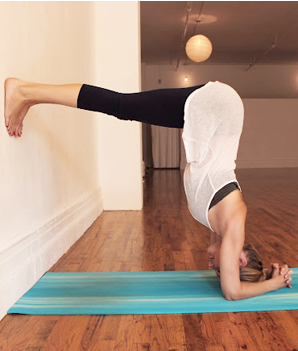
Supported Headstand
Headstand increases the circulation of blood and oxygen to the brain, calming the mind. As it is not safe for all necks to do headstand, I recommend this supported variation against the wall. Of COURSE, if praciting this pose (or any of the others) would cause anxiety, PLEASE leave it (them) out.
Measure a leg’s distance away from the wall to determine where to put elbows. Face away from the wall on all fours. Place forearms on the ground, make a basket with hands, and gently rest head on the ground, lightly pressing back of head into hands. From there, walk feet up the wall until body is in an “L” position. If you have a sensitive neck, press firmly into forearms so that head is just above the ground. Stay here for at least five deep breaths, then come down and take a child’s pose for at least five deep breaths to counterbalance the headstand, normalize circulation, and calm the mind even more.
“A single session of yoga can help lower anxiety in the moment, but like other relaxation techniques or coping mechanisms, by practicing regularly, you can lower your baseline level of emotional arousal so when you are faced with anxiety in the moment, or a very stressful situation like now, you can act in a more calm and rational way instead of simply reacting out of emotion.” – Dr. Rachel Goldman.
If you enjoy these poses, try our CrossFlowRx: Yoga for Anxiety NOW on CrossFlow Yoga! Start your 2-week free trial TODAY!
Soak in more of Dr. Rachel’s wisdom:
Website: http://www.drrachelnyc.com/ Instagram: https://www.instagram.com/drrachelnyc/
A note from Dr. Rachel: How one manages stress and anxiety may look very different to different people. The relaxation techniques or coping mechanisms that work for someone else might not work for you. It’s important to build your own toolbox of coping skills that you can use when you need them. You may find that certain coping skills, such as yoga, work best for you at certain times, but other coping skills, may work for other emotions. It is therefore recommended to have a variety of coping skills in your toolbox that you can pull from and use when you need them. Remember this is not intended to be a substitute for medical advice and to always consult with a healthcare professional for your specific health needs.
Photos: Vera Boykewich



